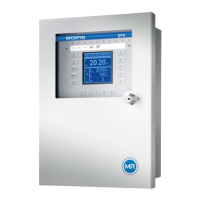6 Commissioning
Maschinenfabrik Reinhausen 201454 3550953/00 ENTAPCON® 230 pro
8. If necessary, press until the control deviation dU is shown.
ð The control deviation dU must be negative.
If the control deviation appears in the opposite direction, change the polarity
of the current transformer.
9. Set the Z compensation and Z compensation limit value parameters
to the desired operating values.
ð The function test for Z compensation is complete.
Checking parallel operation
This section describes how you can run the function test for parallel opera-
tion.
To obtain perfect functioning in parallel operation, the voltage regulator must
be commissioned in simplex mode. Make sure that the conditions below
have been fulfilled.
▪ All devices are set to the same operating parameters for desired value,
circulating reactive current sensitivity and delay time T1.
▪ The circulating reactive current sensitivity on all devices must be set to
0 %.
▪ The circulating reactive current blocking parameter must be set to
20 %.
▪ You must undertake all settings in manual mode.
▪ Each device needs an individual address on the CAN bus.
Checking circulating reactive current sensitivity
This section describes how to run the function test for circulating reactive
current sensitivity.
1. Adjust both transformers in simplex mode to the same actual voltage by
means of the on-load tap-changer.
ð When both devices are in a state of equilibrium, then the value of
the control deviation dV [%] is smaller than the set bandwidth. You
can see this in the main screen if the mark for the measured volt-
age U
actual
is within the bandwidth.
2. Connect the transformers in parallel and enable the parallel control.
ð The two devices must still be in a state of equilibrium.
ð The Parallel operation LED on the front panel is illuminated.
3. On one of the two transformers, raise the tap position of the on-load tap-
changer by one setting; on the second transformer, lower the tap posi-
tion of the on-load tap-changer by one setting.
ð The two devices must still be in a state of equilibrium.
6.3.3
Requirements
6.3.3.1

